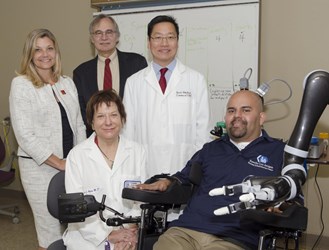Intent-Controlled Prosthetic Enables More Natural Movement

By attaching an implant to the area of the brain that plans movement, rather than the part of the brain controlling motor function, researchers have found that a robotic prosthetic can be operated using only a patient’s intent. Exploring the potential of this part of the brain, researchers believe, could create options for a more natural mind-controlled prosthetic that moves more smoothly than its predecessors.
Placing an implant in the motor cortex — the area of the brain that sends signals to the appropriate muscles needed to execute movement — may seem intuitive, but previous attempts to operate a prosthetic with this part of the brain have produced mixed results.
Richard Anderson, professor of neuroscience at California Institute of Technology (CIT), believes that the signals dispatched by the motor cortex are too complex for a computer to translate, often resulting in jerky and uncontrolled movement in prosthetic limbs. To improve on this technology, Anderson instead attached the implant to the posterior parietal cortex (PPC), the area of the brain that processes intent to move.
“When you move your arm, you really don’t think about which muscles to activate and the details of the movement. Instead, you think about the goal of the movement. For example, ‘I want to pick up that cup of water,’” Anderson said in a CIT press release.
By placing the implant earlier in the chain of neural signals, the patient could conceivably move a prosthetic simply by imagining what he wanted to do.
“We hoped that the signals from the PPC would be easier for patients to use, ultimately making the movement process more intuitive,” said Anderson.
Anderson’s team, whose early study results were published in Science in March, attached to a patient two small electrode arrays, each containing 192 active electrons to correspond with each neuron in the PPC. The arrays then were attached to a computer that decoded the neural signals and sent direction to a prosthetic designed by a team at the Johns Hopkins University Applied Physics Laboratory.
Anderson’s predictions proved to be correct, and his team’s research subject, a tetraplegic man named Erik Sorto, was able to operate the prosthetic, on his first try.
“The PPC is a rich source of signals that can be used to determine the goals of a paralyzed subject,” said Anderson in a Reuters article. “These signals can be used to control ‘smart’ robotics and computers that can work out the details of movement of external devices such as a robotic limb.”
Anderson and his team hope to further refine the prosthetic to process touch, as well as visual cues, and to enable more refined and complex tasks.
“Our future studies will investigate ways to combine the detailed motor cortex signals with more cognitive PPC signals to take advantage of each area’s specializations,” said Anderson.
